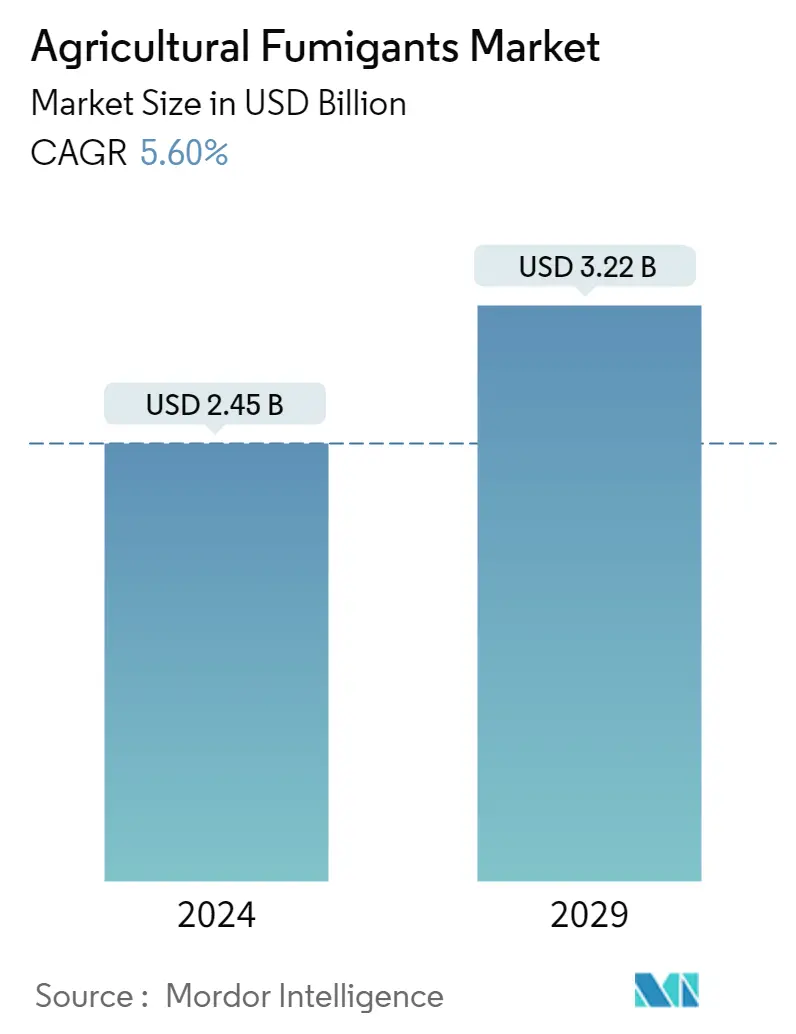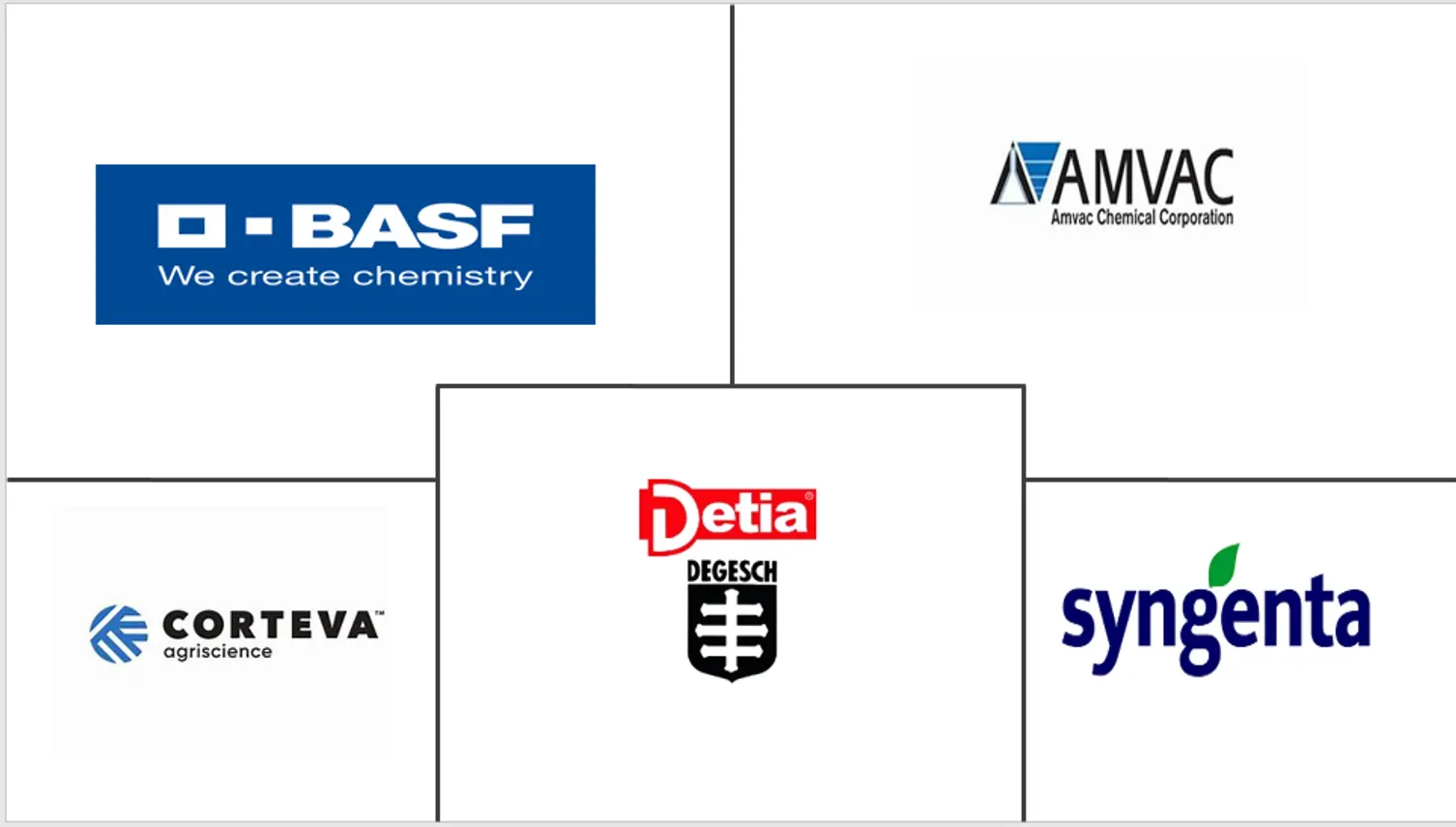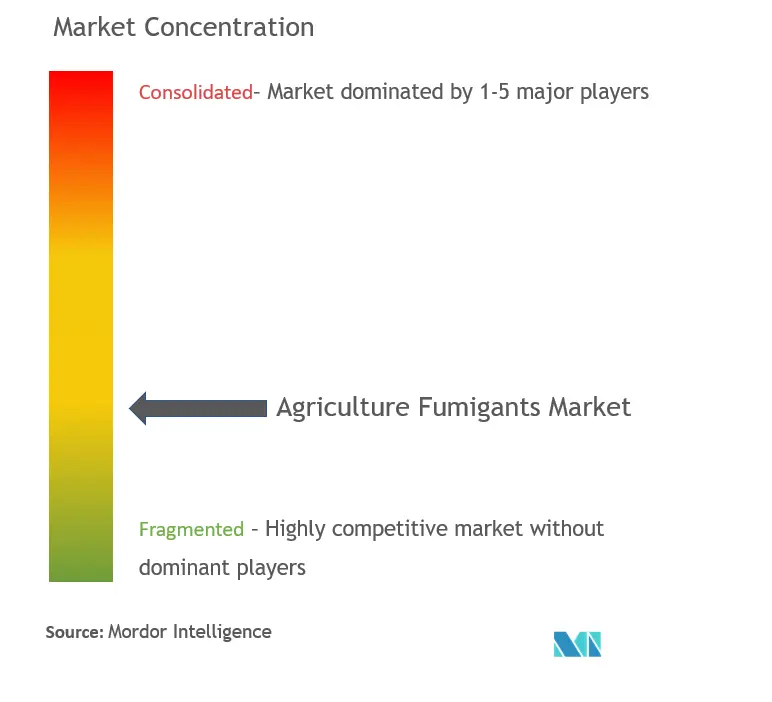Agricultural Fumigants Market Size

| Study Period | 2019 - 2029 |
| Market Size (2024) | USD 2.45 Billion |
| Market Size (2029) | USD 3.22 Billion |
| CAGR (2024 - 2029) | 5.60 % |
| Fastest Growing Market | Asia-Pacific |
| Largest Market | North America |
Major Players
*Disclaimer: Major Players sorted in no particular order |
Agricultural Fumigants Market Analysis
The Agricultural Fumigants Market size is estimated at USD 2.45 billion in 2024, and is expected to reach USD 3.22 billion by 2029, growing at a CAGR of 5.60% during the forecast period (2024-2029).
The COVID-19 pandemic disrupted the operations of the crop protection chemicals market, including fumigants. The pandemic affected supply chain networks, resulting in losses for companies and farmers. In terms of supply, a short-term shortage of migrant laborers amid distribution bottlenecks created a wide gap between the number of workers required for production. Some other restraints included customs clearances, export permits, import permits, and phytosanitary certificates.
The agricultural fumigants market is driven by factors, like rapid technological advancements in the agricultural sector, growing concerns over post-harvest losses, and a shift in the advanced farming practices, which have led to increased yields. The use of fumigants during storage helps in the reduction of storage loss. Thus, the demand for fumigants is expected to increase as the use of fumigants is an effective and economical method to reduce post-harvest losses.
A widely used fumigant for storing agricultural commodities while offering protection against insects and rodents, phosphine-based fumigants have emerged as the largest segment among all types of global fumigants. North America dominates the market. With rapid investments in technology and R&D, many new varieties of products are being developed with less toxicity and more efficiency. The growth of the agricultural fumigants market can be attributed to several factors, such as the increased inclination of consumers for improving the quality of agricultural output, changing farming practices, and advanced storage technology. However, fumigants cause several problems, including possible phytotoxicity, depending on the type of crop and its variety, seasonal conditions, humidity, temperature, fumigant concentration, and duration of treatment. Therefore, it is recommended to be used by professional fumigators only due to its high toxicity as a respiratory poison.
Agricultural Fumigants Market Trends
This section covers the major market trends shaping the Agricultural Fumigants Market according to our research experts:
Growing Agricultural Production
In line with increasing agricultural production, the demand for fumigants has been witnessing an upward trend over the years. The use of fumigation has increased at all levels of the grain and oilseeds supply chain, emerging as the main insect management option at the farm level. For farm-level storage and in silos, fumigation is among the most preferred methods to prevent the build-up of insect infestations while avoiding pest resistance. However, the available active substances are constrained to a limited number of fumigants and storage insecticides due to legislative restrictions. Methyl bromide (MB) fumigation is an effective treatment to ensure that products pose a minimal phytosanitary risk. While the European Union has banned the use of MB, Canada still requires it as the only approved treatment for the quarantine and pre-shipment applications of some products.
The Food and Agriculture Organization (FAO) of the United Nations has predicted that agricultural productivity is likely to increase by 70% by 2050 in order to meet the growing demand for food. The demand for agricultural crops is expected to rise to around 6,759 million ton by 2050. Global cereal production increased from 2906.5 million ton in 2018 to 2996.1 million ton in 2020. Thus, the demand for agricultural warehouses, storage technologies, and associated products, like fumigants, is anticipated to grow in the long run. In warehouses, pests damage most crops, and the use of fumigants decrease the loss of agricultural products. Therefore, this is expected to boost demand for the agricultural fumigants market across the world.

North America Leading the Global Market
North America is the largest market for agricultural fumigants, with over 250 authorized products available in its major countries. Management of stored product insects is a major concern and widely researched topic in the food and grain processing and storage industry.
The major commodities consuming fumigants for both storage and soil applications in the region are corn, rice, barley, potato, tomato, wheat, strawberry, cabbage, etc. In North America, the United States is the largest market, accounting for more than half of the regional market's share. The major fumigants in the US market include chloropicrin, sulfuryl fluoride, aluminum phosphide, ethylene oxide, etc. Over 90 fumigant-based products are registered in Canada, manufactured by 25 companies. A few key players are AMVAC Chemicals, Degesch America Inc., Syngenta Canada Inc., United Phosphorus Inc., etc.

Agricultural Fumigants Industry Overview
The global agricultural fumigants market is consolidated, with a few companies occupying the largest market share. The markets in North America and Europe are highly consolidated, with a few major players occupying large market shares and having a high level of competition. Diversification of portfolios through R&D, which is the backbone of the introduction of new products, is one of the prominent strategies being applied to the matured markets for further intensification.
Agricultural Fumigants Market Leaders
-
Syngenta International AG
-
Amvac Chemical Corporation
-
Corteva Agriscience
-
BASF
-
Detia Degesch GmbH
*Disclaimer: Major Players sorted in no particular order

Agricultural Fumigants Market News
In January 2022, UPL Ltd entered an agreement in which Bunge Ltd will acquire a 33% stake in Sinagro to strengthen its grain orientation strategy in Brazil.
In 2018, The Australia-China Joint Centre for Postharvest Grain Biosecurity and Quality Research entered a partnership to focus on finding new and improved ways to minimize losses in stored grain through the development of non-chemical controls.
In 2017, India introduced obligatory phytosanitary requirements for exporting countries to use methyl bromide for fumigation of grain crops imported into India.
Agricultural Fumigants Market Report - Table of Contents
1. INTRODUCTION
- 1.1 Study Assumptions and Market Definition
- 1.2 Scope of the Study
2. RESEARCH METHODOLOGY
3. EXECUTIVE SUMMARY
4. MARKET DYNAMICS
- 4.1 Market Drivers
- 4.2 Market Restraints
-
4.3 Porter's Five Forces Analysis
- 4.3.1 Bargaining Power of Suppliers
- 4.3.2 Bargaining Power of Buyers/Consumers
- 4.3.3 Threat of New Entrants
- 4.3.4 Threat of Substitute Products
- 4.3.5 Intensity of Competitive Rivalry
5. MARKET SEGMENTATION
-
5.1 Type
- 5.1.1 Methyl Bromide
- 5.1.2 Chloropicrin
- 5.1.3 Phosphine
- 5.1.4 Metam Sodium
- 5.1.5 1,3-Dichloropropene
- 5.1.6 Other Agricultural Fumigants
-
5.2 Method of Application
- 5.2.1 Soil
- 5.2.2 Warehouse
-
5.3 Form
- 5.3.1 Solid
- 5.3.2 Liquid
- 5.3.3 Gas
-
5.4 Crop Application
- 5.4.1 Crop-based
- 5.4.2 Non-crop-based
-
5.5 Geography
- 5.5.1 North America
- 5.5.1.1 United States
- 5.5.1.2 Canada
- 5.5.1.3 Mexico
- 5.5.1.4 Rest of North America
- 5.5.2 Europe
- 5.5.2.1 Germany
- 5.5.2.2 United Kingdom
- 5.5.2.3 France
- 5.5.2.4 Russia
- 5.5.2.5 Spain
- 5.5.2.6 Italy
- 5.5.2.7 Rest of Europe
- 5.5.3 Asia-Pacific
- 5.5.3.1 China
- 5.5.3.2 Japan
- 5.5.3.3 India
- 5.5.3.4 Australia
- 5.5.3.5 Rest of Asia-Pacific
- 5.5.4 South America
- 5.5.4.1 Brazil
- 5.5.4.2 Argentina
- 5.5.4.3 Rest of South America
- 5.5.5 Africa
- 5.5.5.1 South Africa
- 5.5.5.2 Rest of Africa
6. COMPETITIVE LANDSCAPE
- 6.1 Most Adopted Strategies
- 6.2 Market Share Analysis
-
6.3 Company Profiles
- 6.3.1 DowDuPont
- 6.3.2 Amvac Chemical Corporation
- 6.3.3 Syngenta AG
- 6.3.4 UPL Group
- 6.3.5 Detia Degesch GmbH
- 6.3.6 ADAMA Agricultural Solution Ltd
- 6.3.7 BASF SE
- 6.3.8 Cytec Solvay Group
- 6.3.9 FMC Corporation
- 6.3.10 Fumigation Services
- 6.3.11 Ikeda Kogyo Co. Ltd
- 6.3.12 Industrial Fumigation Company
- 6.3.13 Isagro SpA
- 6.3.14 Lanxess
- 6.3.15 Reddick Fumigants LLC
- 6.3.16 Trical Inc.
- 6.3.17 TriEst Ag Group Inc.
- 6.3.18 VFC
- 6.3.19 Industrial Fumigation Company
- *List Not Exhaustive
7. MARKET OPPORTUNITIES AND FUTURE TRENDS
8. AN ASSESSMENT OF IMPACT OF COVID-19 ON THE MARKET
** Subject To AvailablityAgricultural Fumigants Industry Segmentation
Fumigants are pesticides that, when applied to soil, form a gas to control pests that live in the soil and disrupt plant growth and crop production. The agricultural fumigants market is segmented by type (methyl bromide, chloropicrin, phosphine, metam sodium, 1,3-dichloropropene, and other agricultural fumigants), method of application (soil and warehouse), form (solid, liquid, and gas), application (crop-based and non-crop-based), and geography (North America, Europe, Asia-Pacific, South America, and Africa). The report offers market size and forecasts in terms of value (USD million) for all the above segments.
| Type | Methyl Bromide | |
| Chloropicrin | ||
| Phosphine | ||
| Metam Sodium | ||
| 1,3-Dichloropropene | ||
| Other Agricultural Fumigants | ||
| Method of Application | Soil | |
| Warehouse | ||
| Form | Solid | |
| Liquid | ||
| Gas | ||
| Crop Application | Crop-based | |
| Non-crop-based | ||
| Geography | North America | United States |
| Canada | ||
| Mexico | ||
| Rest of North America | ||
| Geography | Europe | Germany |
| United Kingdom | ||
| France | ||
| Russia | ||
| Spain | ||
| Italy | ||
| Rest of Europe | ||
| Geography | Asia-Pacific | China |
| Japan | ||
| India | ||
| Australia | ||
| Rest of Asia-Pacific | ||
| Geography | South America | Brazil |
| Argentina | ||
| Rest of South America | ||
| Geography | Africa | South Africa |
| Rest of Africa |
Agricultural Fumigants Market Research FAQs
How big is the Agricultural Fumigants Market?
The Agricultural Fumigants Market size is expected to reach USD 2.45 billion in 2024 and grow at a CAGR of 5.60% to reach USD 3.22 billion by 2029.
What is the current Agricultural Fumigants Market size?
In 2024, the Agricultural Fumigants Market size is expected to reach USD 2.45 billion.
Who are the key players in Agricultural Fumigants Market?
Syngenta International AG, Amvac Chemical Corporation, Corteva Agriscience, BASF and Detia Degesch GmbH are the major companies operating in the Agricultural Fumigants Market.
Which is the fastest growing region in Agricultural Fumigants Market?
Asia-Pacific is estimated to grow at the highest CAGR over the forecast period (2024-2029).
Which region has the biggest share in Agricultural Fumigants Market?
In 2024, the North America accounts for the largest market share in Agricultural Fumigants Market.
What years does this Agricultural Fumigants Market cover, and what was the market size in 2023?
In 2023, the Agricultural Fumigants Market size was estimated at USD 2.32 billion. The report covers the Agricultural Fumigants Market historical market size for years: 2019, 2020, 2021, 2022 and 2023. The report also forecasts the Agricultural Fumigants Market size for years: 2024, 2025, 2026, 2027, 2028 and 2029.
Agricultural Fumigants Industry Report
Statistics for the 2024 Agricultural Fumigants market share, size and revenue growth rate, created by Mordor Intelligence™ Industry Reports. Agricultural Fumigants analysis includes a market forecast outlook to 2029 and historical overview. Get a sample of this industry analysis as a free report PDF download.



